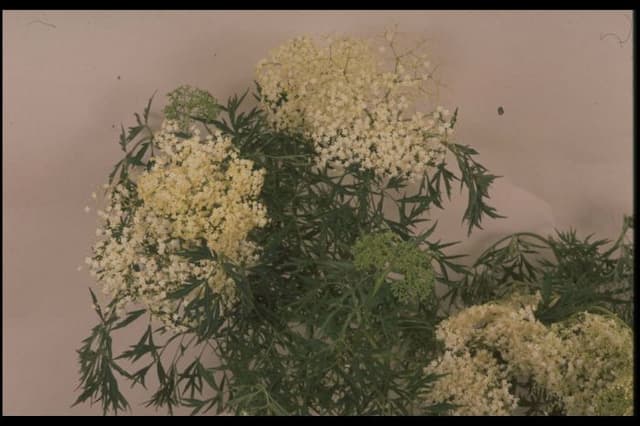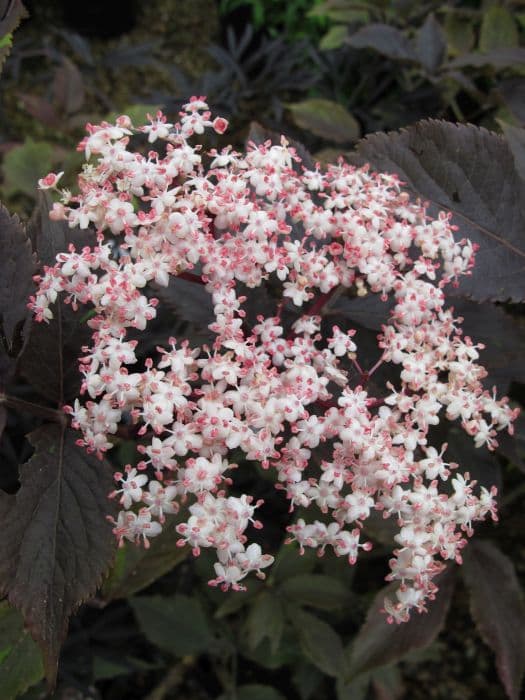Japanese snowball [Kilimanjaro Sunrise] Viburnum plicatum f. tomentosum Kilimanjaro Sunrise = 'Jww5' (PBR)
![Japanese snowball [Kilimanjaro Sunrise]](/_next/image?url=https%3A%2F%2Fplants-admin.emdemapps.com%2Fimages%2Fplants%2F%2Fimages%2F604b58aa1dac7.png&w=3840&q=75)
ABOUT
[Kilimanjaro Sunrise] is a compact, slow-growing shrub with heart-shaped dark-green, deeply veined leaves. White lace-cap flowers, in profusion, cover the plant in spring and become flushed with an apple-blossom pink during summer. Flowers are followed by deep-red berries which become black; rich autumn foliage colour of orange and red
About this plant
 Names
NamesFamily
Adoxaceae.
Synonyms
Kilimanjaro Sunrise Japanese Snowball, Doublefile Viburnum Kilimanjaro Sunrise.
Common names
Viburnum plicatum f. tomentosum Kilimanjaro Sunrise = 'Jww5' (PBR)
 Characteristics
CharacteristicsLife cycle
Perennials
Foliage type
Deciduous
Color of leaves
Green
Flower color
White
Height
6-8 feet (1.8-2.4 meters)
Spread
6-8 feet (1.8-2.4 meters)
Plant type
Shrub
Hardiness zones
5-8
Native area
Japan
Benefits
 General Benefits
General Benefits- Ornamental Value - Displays layers of pure white lace-cap flowers that transform into pink as they age, adding aesthetic appeal to gardens and landscapes.
- Compact Growth Habit - Suitable for small gardens and spaces due to its relatively compact size and upright, pyramidal form.
- Seasonal Interest - Offers year-round interest with spring blooms, summer berries, vibrant autumn foliage, and a structured winter silhouette.
- Low Maintenance - Requires minimal pruning and care once established, making it a practical choice for gardeners of all levels.
- Wildlife Attraction - Produces red to black berries that attract birds and beneficial insects, enhancing biodiversity.
- Tolerance - Shows resilience to many common pests and diseases, reducing the need for chemical treatments.
- Versatility - Can be used as a specimen plant, in mixed borders, or as part of a hedge or screen, providing flexibility in landscape design.
 Medical Properties
Medical PropertiesThis plant is not used for medical purposes.
 Air-purifying Qualities
Air-purifying QualitiesThis plant is not specifically known for air purifying qualities.
 Other Uses
Other Uses- Photography Prop: The beautiful blossoms of the Japanese Snowball 'Kilimanjaro Sunrise' make it an excellent background or subject for photographers, particularly in macro photography or botanical showcases.
- Artistic Inspiration: Artists may use the intricate bloom structures and leaf patterns of Japanese Snowball as inspiration for botanical illustrations, paintings, or textile designs.
- Educational Tool: Schools and educational programs can utilize the Japanese Snowball in botany lessons to demonstrate plant growth, flowering stages, and pollination processes.
- Festive Decorations: The flowers and branches of Japanese Snowball can be used in making wreaths or as part of floral arrangements for celebrations and festive occasions.
- Culinary Presentation: Although not edible, the flowers can be used as a garnish for plating in high-end culinary presentations, as long as they don't come into contact with food.
- Garden Sculpture: Trimming and shaping the Japanese Snowball into topiaries can turn the plant into a living sculpture, enhancing the aesthetic of a garden.
- Boundary Planting: The dense foliage of Japanese Snowball makes it an effective plant for marking property boundaries in a visually appealing way.
- Theme Gardens: This plant is suitable for incorporating into specialty gardens, such as Japanese-themed gardens or white gardens, where a certain color palette is maintained.
- Privacy Screening: When planted in a row, Japanese Snowball bushes can provide a natural privacy screen during the times of the year when they are in leaf.
- Wildlife Habitat: The Japanese Snowball can serve as a habitat for birds and beneficial insects, especially when incorporated into wildlife-friendly garden designs.
Interesting Facts
 Feng Shui
Feng ShuiThe Doublefile Viburnum is not used in Feng Shui practice.
 Zodiac Sign Compitability
Zodiac Sign CompitabilityThe Doublefile Viburnum is not used in astrology practice.
 Plant Symbolism
Plant Symbolism- Renewal: The 'Kilimanjaro Sunrise' variety of Viburnum, commonly known as the Japanese Snowball, produces new blossoms each spring, symbolizing fresh starts and renewal.
- Abundance: With its lush, round flower clusters, the Japanese Snowball represents abundance and generosity.
- Beauty and Purity: The white flowers of the plant can symbolize beauty, purity, and innocence, echoing the color's symbolic associations in many cultures.
- Longevity: Viburnum plants are known for their longevity, and as such, they are often associated with endurance and the resilience of life.
- Protection: In some traditions, Viburnum species, including the Japanese Snowball, are thought to offer protection and are planted for this purpose.
 Water
WaterJapanese Snowball 'Kilimanjaro Sunrise' prefers evenly moist soil, so water the plant deeply about once a week, providing about 1 to 1.5 gallons for smaller shrubs and up to 2 to 3 gallons for larger mature plants. Increase watering frequency during hot, dry spells to maintain soil moisture, and reduce during winter when the plant is dormant. It’s important to avoid waterlogging, so ensure good drainage and allow the top inch of soil to dry out between waterings to prevent root rot.
 Light
LightJapanese Snowball 'Kilimanjaro Sunrise' thrives in full sun to partial shade. The ideal spot for this plant would be where it can receive at least six hours of sunlight daily but is protected from the harsh afternoon sun, especially in warmer climates. Dappled sunlight or morning sun with afternoon shade is perfect for encouraging healthy blooms and foliage.
 Temperature
TemperatureJapanese Snowball 'Kilimanjaro Sunrise' is hardy and can tolerate a range of temperatures from as low as -20°F to as high as 90°F. However, the ideal temperature range for this plant to thrive is between 60°F and 80°F. It’s important to provide some protection from extreme winter chills and hot summer afternoons to ensure the health of the plant.
 Pruning
PruningPrune Japanese Snowball 'Kilimanjaro Sunrise' to maintain shape and encourage healthier, more robust growth. It's best to prune immediately after the shrub has finished blooming, typically in late spring or early summer. Removing any dead or diseased branches and lightly shaping the plant at this time ensures that flower buds for the next year are not removed, as this variety blooms on old wood.
 Cleaning
CleaningAs needed
 Soil
SoilThe Japanese Snowball 'Kilimanjaro Sunrise' requires a soil mix with good drainage that is rich in organic matter. Loamy soil with a pH range of 5.5 to 6.5 is ideal for optimal growth and flowering. A blend of two parts garden soil, one part peat moss or compost, and one part perlite or coarse sand is recommended to provide the necessary conditions.
 Repotting
RepottingJapanese Snowball 'Kilimanjaro Sunrise' typically doesn't need frequent repotting as it is usually grown as a landscape shrub. However, if grown in containers, repotting every 2 to 3 years in the spring can be beneficial to refresh the soil and accommodate root growth.
 Humidity & Misting
Humidity & MistingThe Japanese Snowball 'Kilimanjaro Sunrise' prefers average to high humidity levels but is quite adaptable and can tolerate a range of humidity conditions typically found in outdoor garden settings.
 Suitable locations
Suitable locationsIndoor
Place in bright, indirect light and monitor soil moisture.
Outdoor
Plant in partial shade to full sun; mulch and water regularly.
Hardiness zone
5-8 USDA
 Life cycle
Life cycleThe life cycle of the Japanese snowball 'Kilimanjaro Sunrise' begins with seed germination, where under suitable conditions, seeds develop into young seedlings. These seedlings grow through a juvenile phase, eventually maturing into flowering shrubs with a characteristic tiered habit. The mature plants bloom in spring, producing large, lacecap-style white flower clusters that attract pollinators. After pollination, if successful, the flowers develop into small red fruits that mature to black, which are often consumed by birds, aiding in seed dispersal. Over many years, the shrubs reach their peak size and can continue to flower annually. In the final stage of their life cycle, the plants will eventually senesce and die, completing their lifecycle.
 Propogation
PropogationPropogation time
Spring-Early Summer
The most commonly employed method for propagating the Doublefile Viburnum 'Kilimanjaro Sunrise' is through semi-hardwood cuttings. Typically, this is done in the late summer. Cuttings should be taken from healthy, mature shrubs, making sure each cutting is about 4 to 6 inches long, which equates to roughly 10 to 15 centimeters. The bottom leaves are removed, and the cut end is usually dipped in a rooting hormone to increase the chances of successful rooting. Then, the prepared cuttings are placed in a potting mix with good drainage and kept in a warm, humid environment until roots develop, which often takes several weeks. During this period, the cuttings should be kept under indirect light and consistently moist to facilitate rooting.









